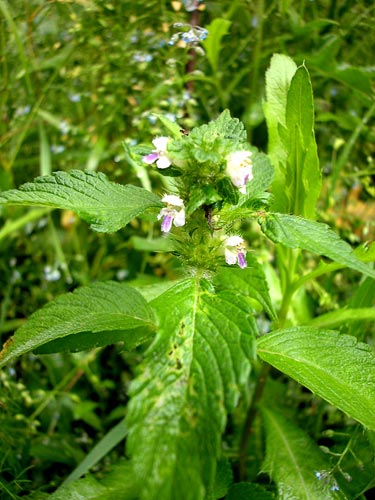Weeds
Galeopsis bifida Boenn. - Bifid Hemp-Nettle.
Systematic position.
Family Lamiaceae, genus Galeopsis L.Biological group.
Annual germiniparous weed.Morphology and biology.
Stem is 20-70 cm tall; bulges under nodes and internodes are dense and bristly. Leaves are lanceolate or ovate-lanceolate, tapered at base, usually densely pubescent with fluffy hairs; with low, connivent, rather blunt serration at edges; petioles have fluffy hairs. Inflorescence is false whorl; flowers are sessile, 6-10 per whorl, located in leaf axils. Calyx has pointed serration, the teeth of which are almost as long as tube of corolla. Corolla is small, purple, violet, sulfur-yellow or nearly white; middle lobe of lower labia is narrow, constricted at base, with a small emargination at apex. Fauces has yellow spot and pattern of three parallel, purple-brown lines reaching the very end of the lobe and connected by transverse lines; free part of the lobe has a continuous lilac-purple spot. Nutlets are tri-hedral, widely rounded toward the tip, tapered toward the base, smooth, bright. Nutlets are variegated in color: marble, dark brown, or brown-reddish with light gray spots. One plant forms 1 to 10,000 nutlets, which retain germination capacity in soil for up to 14 years. Flowering period is June-September. The species is especially abundant in places with sparse herbage. Sufficiently dense herbage depresses it quite strongly.Distribution.
Scandinavia, Central Europe, Asia Minor, Mongolia, Japan, Korea, and North America (adventive plant). European region of the former USSR, the Caucasus, Western Siberia, Eastern Siberia, the Far East, and northern regions of Central Asia.Ecology.
Prefers poor-lime and peaty soils.Economic significance.
Weed of grain crops, especially summer ones, tilled crops, and fodder grasses; occurs in kitchen gardens, fallow lands, wastelands, and along roads. Control measures include removing the stubble in early autumn followed by deep plowing, inter-row cultivation of tilled crops, and chemical weeding.Related references:
Agaev, M.G., ed. 1988. Main agricultural weeds in crops of the Leningrad Region. Catalogue of VIR world collection. Issue 468. Leningrad: VIR, 112 p. (in Russian).Keller, B.A., Lyubimenko, V.N., Mal'tsev, A.I., Fedchenko, B.A., Shishkin, B.K., Rozhevits, R.Yu. & Kamenskii, K.V., eds. 1934. Weed plants of the USSR. V.4. Leningrad: AN SSSR, 414 p. (in Russian).
Shishkin, B.K., ed. 1954. Flora of the USSR. V.21. Moscow & Leningrad: AN SSSR, 704 p. (in Russian).
Ulyanova, T.N. 1988. Weed plants in the flora of Russia and other CIS states. St. Petersburg: VIR, 344 p. (in Russian).
Volkov, A.N., ed. 1935. Areas of distribution of the major weed plants in the USSR. Moscow & Leningrad: State Publishing House of Kolkhoz and Sovkhoz Literature, 152 p. (in Russian).


